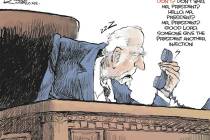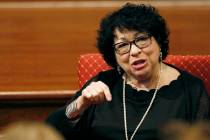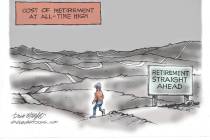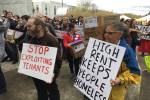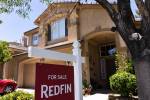Local housing market heating up
It’s happening again. Not nearly to the degree of the boom years, but if you listen closely, you can hear it.
People are talking about what their houses are worth again. In a good way.
At the gym. At Happy Hour. At the park. At the grocery store. “You won’t believe what the house four doors down just sold for.”
The six-year beat down on this valley’s economy — ground zero of the country’s housing crash — has destroyed dreams, ruined livelihoods and punished untold thousands of local families. The boom years of the early 2000s, when Las Vegas Valley home values rose faster than any U.S. market ever, linger as a lesson, like the myth of Icarus.
In those days, housing was all anyone talked about. Everyone knew someone who was making a fortune. Flipping wasn’t a dirty word. And homeowners picked up so much equity, so fast, it was like everyone had a six-figure income. No one wanted to say it was too good to last. If you lived it and covered it, you’ll never forget it.
That’s why the conversations I’ve overheard hit me like a shot of espresso. They’re not happening everywhere in the valley, and they’re not happening as often, but they’re happening.
Valleywide, we know that median home prices — in both the new and resale markets — have been climbing for months. Those increases have been driven by a lack of supply. AB284, the state foreclosure prevention law that took effect two years ago, stopped the flow of bank-owned properties onto the resale market. Because most Southern Nevadans are upside-down on their mortgages, they can’t initiate traditional sales, further limiting supply.
The anecdotes of regular folks who’ve tried to buy a home in recent months are quite familiar by now: putting in multiple offers; offering more than list price; getting into bidding wars with cash-paying investors; being shut out. Middle-class neighborhoods are seeing more owner-occupied homes turn into rental properties.
So why, when so many valley residents are still suffering and stuck, unable to buy a home or leave the one they’re in, should they take any good news from what’s happening?
Because housing is recovering.
Yes, it’s a bastardized recovery, driven not by job growth or population growth, but by government sinking its fangs into market forces. But it’s a recovery nonetheless, and a lot of Southern Nevadans homeowners are less and less underwater every month as a result. Some people can see the surface, and some are breaking through. Today, 52 percent of the existing homes for sale in the valley are traditional sales, where the buyer actually has equity, with the other 48 percent being short sales or bank sales.
“In 2012, everyone was waiting for the bottom,” said Dave Tina, president of the Greater Las Vegas Association of Realtors. “Then, in January, everyone realized the bottom was gone, that we’d hit it six months ago. And everyone was like, ‘Uh-oh.’ And they started buying like crazy.”
In February, a record 59.5 percent of all existing homes sold in Southern Nevada were purchased with cash, up from 56.1 percent in January. Tina notes that not all of those cash buyers are investors looking to acquire a rental property — 10 percent are paying cash to get a house to live in.
The price threshold for investor interest is quickly rising beyond middle-class homes. “It’s in the $350,000 range now,” Tina said. “It’s all about return on investment. If you have a nice $350,000 house with a pool and a spa and it can get a good rent, they’ll go for it.” As a result, real estate agents representing families who are trying to purchase with financing increasingly are resorting to cold calls and very personal appeals to find properties.
In the micro-markets of master-planned communities such as Summerlin and Henderson’s Green Valley, what has happened in the new year is staggering. Tina says competition for homes in these neighborhoods is so fierce they’ve seen double-digit appreciation over just the past few months. Homes below $300,000 in these parts of town are pretty much gone the day they’re listed for sale.
Other parts of town are not appreciating quite as rapidly, but they’re appreciating, because buyers are being forced to look everywhere. Year over year, valleywide, the median resale price is up 24 percent to $150,000. On Thursday, Tina said there were slightly more than 3,000 single-family homes available for sale in the valley, a four-week supply. Several years ago, that number was 30,000. “We have no inventory,” he said.
That’s driving more buyers to the new home market, where the median sale price in February was about $234,000. Robb Beville, president of Harmony Homes, says investors are buying new homes as well, but he estimated they’re buying about 20 percent of his inventory — a much lower share than the resale market.
So is this a new bubble? It’s hard to argue that when prices are still so far below pre-recession peak values. For now, it’s a strong recovery.
In a truly healthy housing market, middle-class borrowers have a chance to buy an existing home. It’s ironic that the state and federal governments, which are so determined to champion middle-class housing, have created the environment that has all but shut them out of the resale market when interest rates are at historic lows. I don’t expect our policymakers to back off — especially not when they can claim some credit for driving prices up.
But I will make one prediction about the market: Come December, when the press and pundit class consider the biggest stories of the year, the housing recovery will be No. 1.
Glenn Cook (gcook@reviewjournal.com) is a Review-Journal editorial writer. Follow him on Twitter: @Glenn_CookNV. Listen to him Mondays at 4 p.m. on “Live and Local with Kevin Wall” on KXNT News Radio, 100.5 FM, 840 AM.








